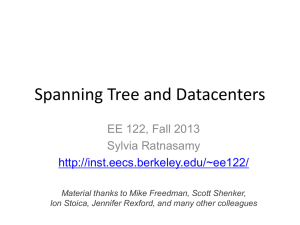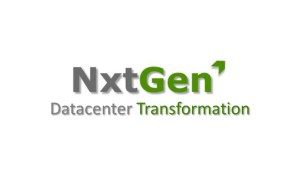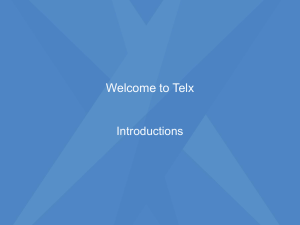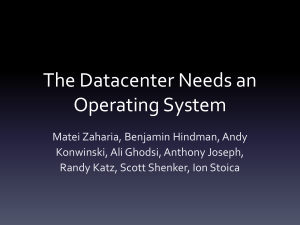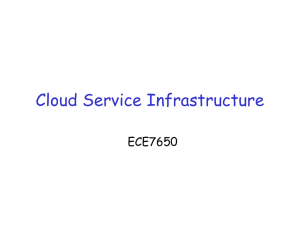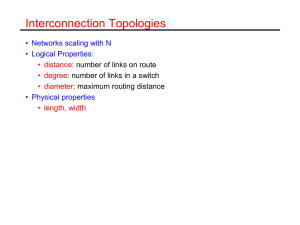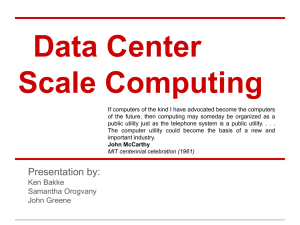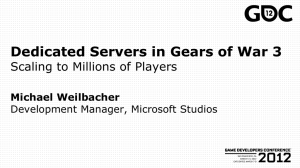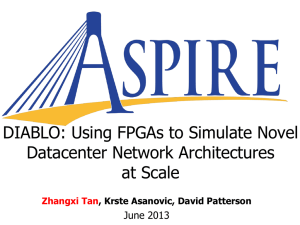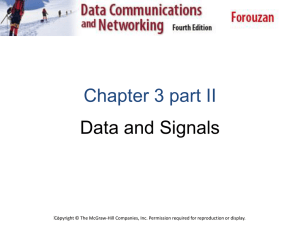Goals
advertisement
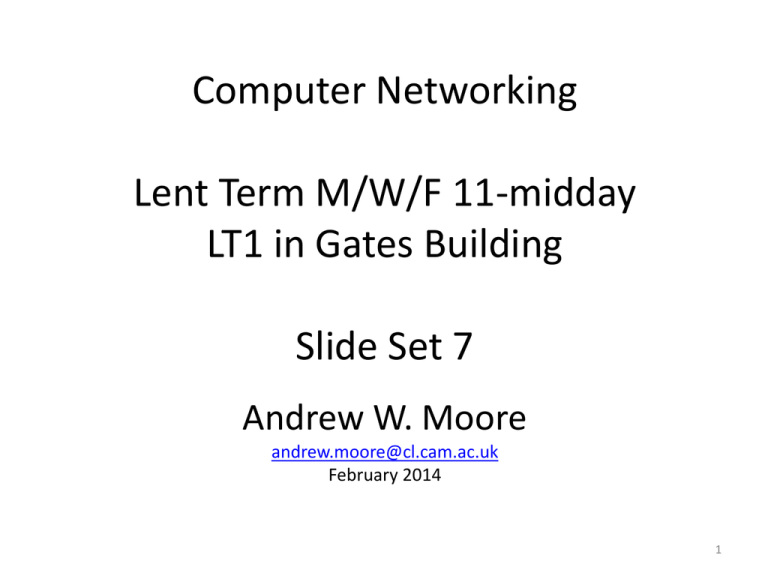
Computer Networking Lent Term M/W/F 11-midday LT1 in Gates Building Slide Set 7 Andrew W. Moore andrew.moore@cl.cam.ac.uk February 2014 1 Datacenters What we will cover (Datacenter Topic 7 is not examinable in 2013-14) • Characteristics of a datacenter environment – goals, constraints, workloads, etc. • How and why DC networks are different (vs. WAN) – e.g., latency, geo, autonomy, … • How traditional solutions fare in this environment – e.g., IP, Ethernet, TCP, ARP, DHCP • Not details of how datacenter networks operate Disclaimer • Material is emerging (not established) wisdom • Material is incomplete – many details on how and why datacenter networks operate aren’t public Why Datacenters? Your <public-life, private-life, banks, government> live in my datacenter. Security, Privacy, Control, Cost, Energy, (breaking) received wisdom; all this and more come together into sharp focus in datacenters. Do I need to labor the point? 5 What goes into a datacenter (network)? • Servers organized in racks 6 What goes into a datacenter (network)? • Servers organized in racks • Each rack has a `Top of Rack’ (ToR) switch 7 What goes into a datacenter (network)? • Servers organized in racks • Each rack has a `Top of Rack’ (ToR) switch • An `aggregation fabric’ interconnects ToR switches 8 What goes into a datacenter (network)? • • • • Servers organized in racks Each rack has a `Top of Rack’ (ToR) switch An `aggregation fabric’ interconnects ToR switches Connected to the outside via `core’ switches – note: blurry line between aggregation and core • With network redundancy of ~2x for robustness 9 Example 1 Brocade reference design 10 Example 2 Internet CR S AR AR S S S S … CR ... S AR AR ... … ~ 40-80 servers/rack Cisco reference design 11 Observations on DC architecture • • • • Regular, well-defined arrangement Hierarchical structure with rack/aggr/core layers Mostly homogenous within a layer Supports communication between servers and between servers and the external world Contrast: ad-hoc structure, heterogeneity of WANs 12 Datacenters have been around for a while 1949, EDSAC 13 What’s new? 14 SCALE! 15 How big exactly? • 1M servers [Microsoft] – less than google, more than amazon • > $1B to build one site [Facebook] • >$20M/month/site operational costs [Microsoft ’09] But only O(10-100) sites 16 What’s new? • Scale • Service model – user-facing, revenue generating services – multi-tenancy – jargon: SaaS, PaaS, DaaS, IaaS, … 17 Implications • Scale – need scalable solutions (duh) – improving efficiency, lowering cost is critical `scale out’ solutions w/ commodity technologies • Service model – performance means $$ – virtualization for isolation and portability 18 Multi-Tier Applications • Applications decomposed into tasks – Many separate components – Running in parallel on different machines 19 Componentization leads to different types of network traffic • “North-South traffic” – Traffic between external clients and the datacenter – Handled by front-end (web) servers, mid-tier application servers, and back-end databases – Traffic patterns fairly stable, though diurnal variations 20 North-South Traffic user requests from the Internet Router Front-End Proxy Web Server Data Cache Front-End Proxy Web Server Data Cache Database Web Server Database 21 Componentization leads to different types of network traffic • “North-South traffic” – Traffic between external clients and the datacenter – Handled by front-end (web) servers, mid-tier application servers, and back-end databases – Traffic patterns fairly stable, though diurnal variations • “East-West traffic” – Traffic between machines in the datacenter – Comm within “big data” computations (e.g. Map Reduce) – Traffic may shift on small timescales (e.g., minutes) 22 East-West Traffic Distributed Storage Map Tasks Reduce Tasks Distributed Storage 23 East-West Traffic CR S … CR AR AR AR AR S S S S S S S S S … .. . S … S … 24 Often doesn’t cross the network Distributed Storage Some fraction (typically 2/3) crosses the network East-West Traffic MapAlways goes over Reduce Tasks the networkTasks Distributed Storage 25 What’s different about DC networks? Characteristics • Huge scale: – ~20,000 switches/routers – contrast: AT&T ~500 routers What’s different about DC networks? Characteristics • Huge scale: • Limited geographic scope: – High bandwidth: 10/40/100G – Contrast: Cable/aDSL/WiFi – Very low RTT: 10s of microseconds – Contrast: 100s of milliseconds in the WAN 27 What’s different about DC networks? Characteristics • Huge scale • Limited geographic scope • Single administrative domain – Can deviate from standards, invent your own, etc. – “Green field” deployment is still feasible 28 What’s different about DC networks? Characteristics • Huge scale • Limited geographic scope • Single administrative domain • Control over one/both endpoints – can change (say) addressing, congestion control, etc. – can add mechanisms for security/policy/etc. at the endpoints (typically in the hypervisor) 29 What’s different about DC networks? Characteristics • Huge scale • Limited geographic scope • Single administrative domain • Control over one/both endpoints • Control over the placement of traffic source/sink – e.g., map-reduce scheduler chooses where tasks run – alters traffic pattern (what traffic crosses which links) 30 What’s different about DC networks? Characteristics • Huge scale • Limited geographic scope • Single administrative domain • Control over one/both endpoints • Control over the placement of traffic source/sink • Regular/planned topologies (e.g., trees/fat-trees) – Contrast: ad-hoc WAN topologies (dictated by real-world geography and facilities) 31 What’s different about DC networks? Characteristics • Huge scale • Limited geographic scope • Single administrative domain • Control over one/both endpoints • Control over the placement of traffic source/sink • Regular/planned topologies (e.g., trees/fat-trees) • Limited heterogeneity – link speeds, technologies, latencies, … 32 What’s different about DC networks? Goals • Extreme bisection bandwidth requirements – recall: all that east-west traffic – target: any server can communicate at its full link speed – problem: server’s access link is 10Gbps! 33 Full Bisection Bandwidth Internet O(40x10x100) Gbps O(40x10)Gbps CR AR AR S S S S CR ... AR AR 10Gbps S S ... … … Traditional tree topologies “scale up” •~ 40-80 fullservers/rack bisection bandwidth is expensive • typically, tree topologies “oversubscribed” 34 A “Scale Out” Design • Build multi-stage `Fat Trees’ out of k-port switches – k/2 ports up, k/2 down – Supports k3/4 hosts: • 48 ports, 27,648 hosts All links are the same speed (e.g. 10Gps) 35 Full Bisection Bandwidth Not Sufficient • To realize full bisectional throughput, routing must spread traffic across paths • Enter load-balanced routing – How? (1) Let the network split traffic/flows at random (e.g., ECMP protocol -- RFC 2991/2992) – How? (2) Centralized flow scheduling? – Many more research proposals 36 What’s different about DC networks? Goals • Extreme bisection bandwidth requirements • Extreme latency requirements – real money on the line – current target: 1μs RTTs – how? cut-through switches making a comeback • reduces switching time 37 What’s different about DC networks? Goals • Extreme bisection bandwidth requirements • Extreme latency requirements – real money on the line – current target: 1μs RTTs – how? cut-through switches making a comeback – how? avoid congestion • reduces queuing delay 38 What’s different about DC networks? Goals • Extreme bisection bandwidth requirements • Extreme latency requirements – real money on the line – current target: 1μs RTTs – how? cut-through switches making a comeback (lec. 2!) – how? avoid congestion – how? fix TCP timers (e.g., default timeout is 500ms!) – how? fix/replace TCP to more rapidly fill the pipe 39 An example problem at scale - INCAST Worker 1 • Synchronized mice collide. Caused by Partition/Aggregate. Aggregator Worker 2 Worker 3 RTOmin = 300 ms Worker 4 TCP timeout 40 The Incast Workload Data Block Synchronized Read R R R 1 R 2 Client 1 3 Switch 2 Client now sends next batch of requests 3 4 4 Server Request Unit (SRU) Storage Servers 41 41 Incast Workload Overfills Buffers Synchronized Read R R R 1 R 2 4 Client 1 3 Switch 2 Requests Received 3 4 Responses 1-3 completed Requests Response 4 Sent dropped 44 Server Request Unit (SRU) Link Idle! 42 Response 4 Resent 42 Queue Buildup Sender 1 • Big flows buildup queues. Increased latency for short flows. Receiver Sender 2 • Measurements in Bing cluster For 90% packets: RTT < 1ms For 10% packets: 1ms < RTT < 15ms 43 Link-Layer Flow Control Common between switches but this is flow-control to the end host too… • Another idea to reduce incast is to employ Link-Layer Flow Control….. Recall: the Data-Link can use specially coded symbols in the coding to say “Stop” and “Start” 44 Link Layer Flow Control – The Dark side Head of Line Blocking…. Such HOL blocking does not even differentiate processes so this can occur between competing processes on a pair of machines – no datacenter required. Waiting for no good reason…. 45 Link Layer Flow Control But its worse that you imagine…. Double down on trouble…. Did I mention this is LinkLayer! That means no (IP) control traffic, no routing messages…. … a whole system waiting for one machine Incast is very unpleasant. Reducing the impact of HOL in Link Layer Flow Control can be done through priority queues and overtaking…. 46 What’s different about DC networks? Goals • Extreme bisection bandwidth requirements • Extreme latency requirements • Predictable, deterministic performance – “your packet will reach in Xms, or not at all” – “your VM will always see at least YGbps throughput” – Resurrecting `best effort’ vs. `Quality of Service’ debates – How is still an open question 47 What’s different about DC networks? Goals • Extreme bisection bandwidth requirements • Extreme latency requirements • Predictable, deterministic performance • Differentiating between tenants is key – e.g., “No traffic between VMs of tenant A and tenant B” – “Tenant X cannot consume more than XGbps” – “Tenant Y’s traffic is low priority” 48 What’s different about DC networks? Goals • Extreme bisection bandwidth requirements • Extreme latency requirements • Predictable, deterministic performance • Differentiating between tenants is key • Scalability (of course) – Q: How’s Ethernet spanning tree looking? 49 What’s different about DC networks? Goals • Extreme bisection bandwidth requirements • Extreme latency requirements • Predictable, deterministic performance • Differentiating between tenants is key • Scalability (of course) • Cost/efficiency – focus on commodity solutions, ease of management – some debate over the importance in the network case 50 Summary • • • • • • new characteristics and goals some liberating, some constraining scalability is the baseline requirement more emphasis on performance less emphasis on heterogeneity less emphasis on interoperability 51
